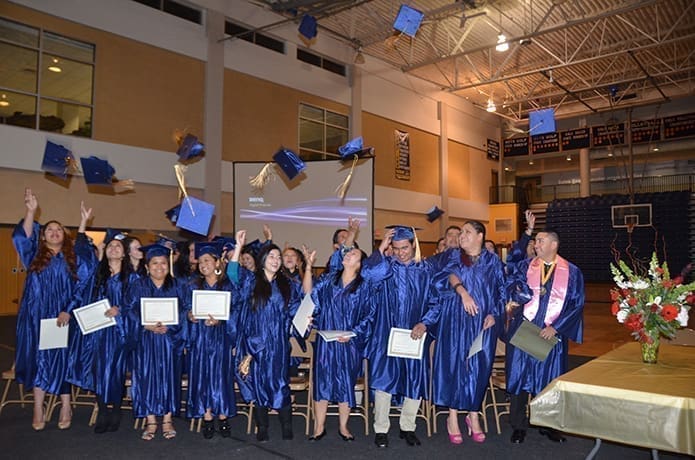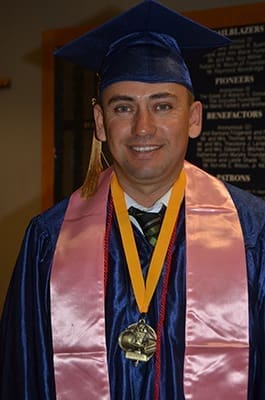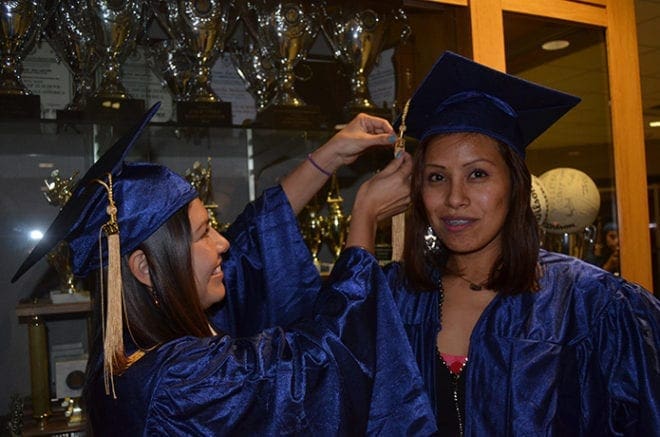 Photo By Cindy Connell Palmer
Photo By Cindy Connell PalmerAtlanta
Marist center opens doors for ‘Dreamers’
By ANDREW NELSON, Staff Writer | Published January 9, 2014
ATLANTA—Lucio Parro would wrap up his workday on Thursdays by telling his crew at a Tennessee construction site where to focus their work before he drove onto the highway so he could make it to class.
It was a weekly routine for the 32-year-old foreman as he pursued his high school equivalency certificate. When he wasn’t driving to class at Marist School, he huddled over his schoolbooks and homework in his hotel room after hours. He said it was all worth it.

Valedictorian of the first graduating class at Centro Hispano Marista, Lucio Parro is a 32-year-old construction supervisor. Photo By Cindy Connell Palmer
“I feel like I got 17 years back in my life. This was my dream always,” said Parro, dressed in a blue graduation cap and gown with a sash around his shoulders as the class valedictorian on Dec. 19. He was moments away from leading a line of students into Marist’s Centennial Center where spouses, children and friends filled the bleachers.
Parro and some three dozen other women and men celebrated as the first graduating class of Centro Hispano Marista. Hundreds of adults have converged on the new program since the fall of 2012 to prepare for the General Educational Development test, or GED. Nearly all are so-called Dreamers who attended to fulfill immigration regulations giving deferred action status to immigrants brought to the country as children. Those who fulfill a list of criteria, which includes earning the GED, can apply for a renewable two-year deferment and work authorization.
Parro came to New Mexico as a teenager illegally. He attended school for a year. But tough times for his family made him leave school to work at 15. It was a dream to return to school even though he was a leader in a successful construction business with some two dozen workers. When his wife phoned him about the news announcing the deferred action program, Parro knew he needed to fulfill his dream.
“I knew it’s not going to be easy, dealing with family, dealing with work. It’s going to be a challenge, but the result is happiness,” said Parro, who has since received his work authorization.
December was a big month for Parro. He marched in the graduation procession and his marriage of 10 years was blessed at Prince of Peace Church, in Flowery Branch. He is a father of three boys. Indeed, his effort in the classroom was to serve as a good example to them in school as they grow up, he said.
In his speech to the supporters, he encouraged his classmates and others to remain focused on the future.
“Embarking on this journey was not the most difficult part. The most difficult part was being able to combine school with work and family; that, as most of my colleagues know, is a big challenge, but in the end it was worth it. I would like to continue studying and we are only one step away from achieving the real goal—a professional career,” he said.
The GED began in 1942 for returning World War II veterans to be tested in math, writing, science and social studies. The veterans who passed the test could apply for jobs or college. Today, it is most often used by people who quit high school. In Georgia, about 1.3 million adults don’t have a high school diploma. In 2011, approximately 18,000 people in the state passed the test to earn their GED. The U.S. Department of Labor reports a person with a high school diploma or GED certificate will earn $7,658 more annually than a non-high school graduate.
Marist opened its doors without charge in August 2012 to serve Dreamers with educational and spiritual needs. The Marist religious community embraced the project as part of an initiative to serve the Atlanta Hispanic community. The goal is to attract adults from Mexico and Central America who lack education and English language skills. According to Centro Hispano Marista, this group represents 14 percent of the total Catholic population in the Archdiocese of Atlanta. A grant from the Catholic Foundation of North Georgia provided some scholarship funds.
Organizers expect 645 students to register for the next round of classes, which are held on Thursday nights from September to May. The program is unique in being the only Spanish and English GED program open to people who are undocumented. More than 50 volunteers teach in the classrooms.
Salvador Arias, one of the founders, said nearly 70 percent of the recent graduates are women. The program touches every part of a student’s life, from home to work, he said. Earning the GED can lead to being accepted for deferred action, which is life changing for immigrants.
“They can legally get married, legally drive, legally work,” he said, adding they no longer have to worry about being deported from their children.

Gloria Pacheco, left, helps friend Angelica Tax with her cap and tassel prior to the graduation. Photo By Cindy Connell Palmer
Ed Prieto, 70, a retired project manager with an MBA, volunteers as an academic adviser and teacher for the advanced classes. Students are “trying to improve themselves by completing their education. They are hard working and good students, for the most part,” said Prieto, a member of Our Lady of the Assumption Church.
The program’s success can be seen in the large number of graduates, he said. Out of his class of 20 or so students, 16 graduated, he said.
“That’s going to triple or quadruple next year. We are happy for that,” he said.
The program also offers a spiritual component, with Mass in Spanish celebrated before class. More than 100 Hispanic adults attended a retreat organized with Our Lady of the Assumption.
To be eligible for deferred action by U.S. Citizenship and Immigration Services, applicants must have arrived in the United States before turning 16, have continuously lived in the United States since June 15, 2007, have a clean criminal record and either be an honorably discharged veteran, currently in school, or recipient of a high school diploma or GED certificate. The applicants also have to have been younger than 31 on June 15, 2012.
Yolanda Abarca, 26, left a Fulton County high school just months before graduation when she became pregnant. She said the GED allows her to close that chapter of her life and look ahead to college. A challenge for her was “being a good mother and being a good student,” she said, adding she’ll encourage her own daughter to focus on schooling. Her goal is to attend community college and complete a degree in business administration. “I’m so nervous, so excited,” she said.
Martha Cruz, 30, juggled cleaning apartments on the overnight shift and classwork.
“I always wanted to finish, but I couldn’t. I just want to finish high school. I want to keep studying more,” said Cruz, who hopes to become a nurse.
More information is available at www.centrohispanomarista.org.